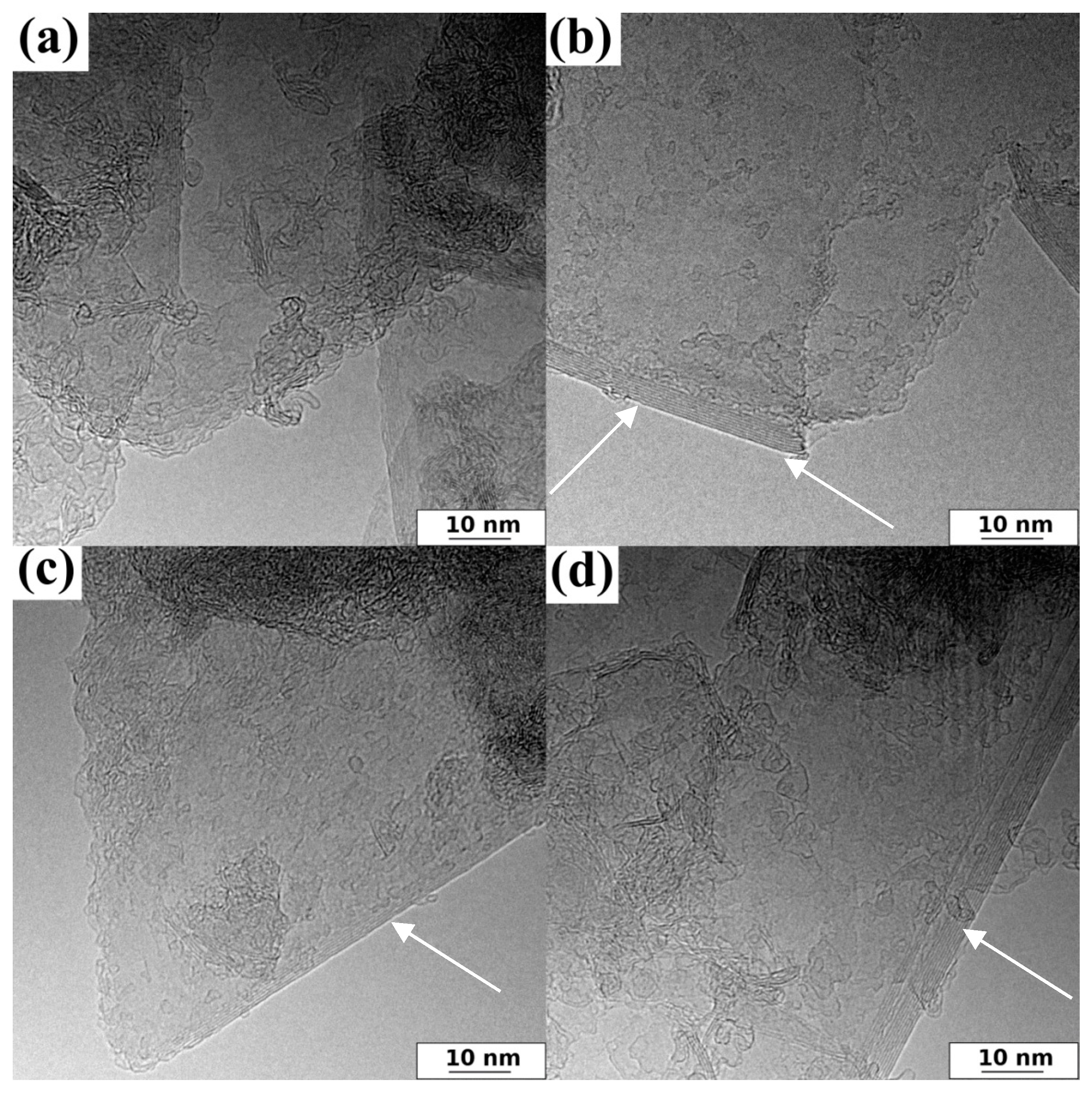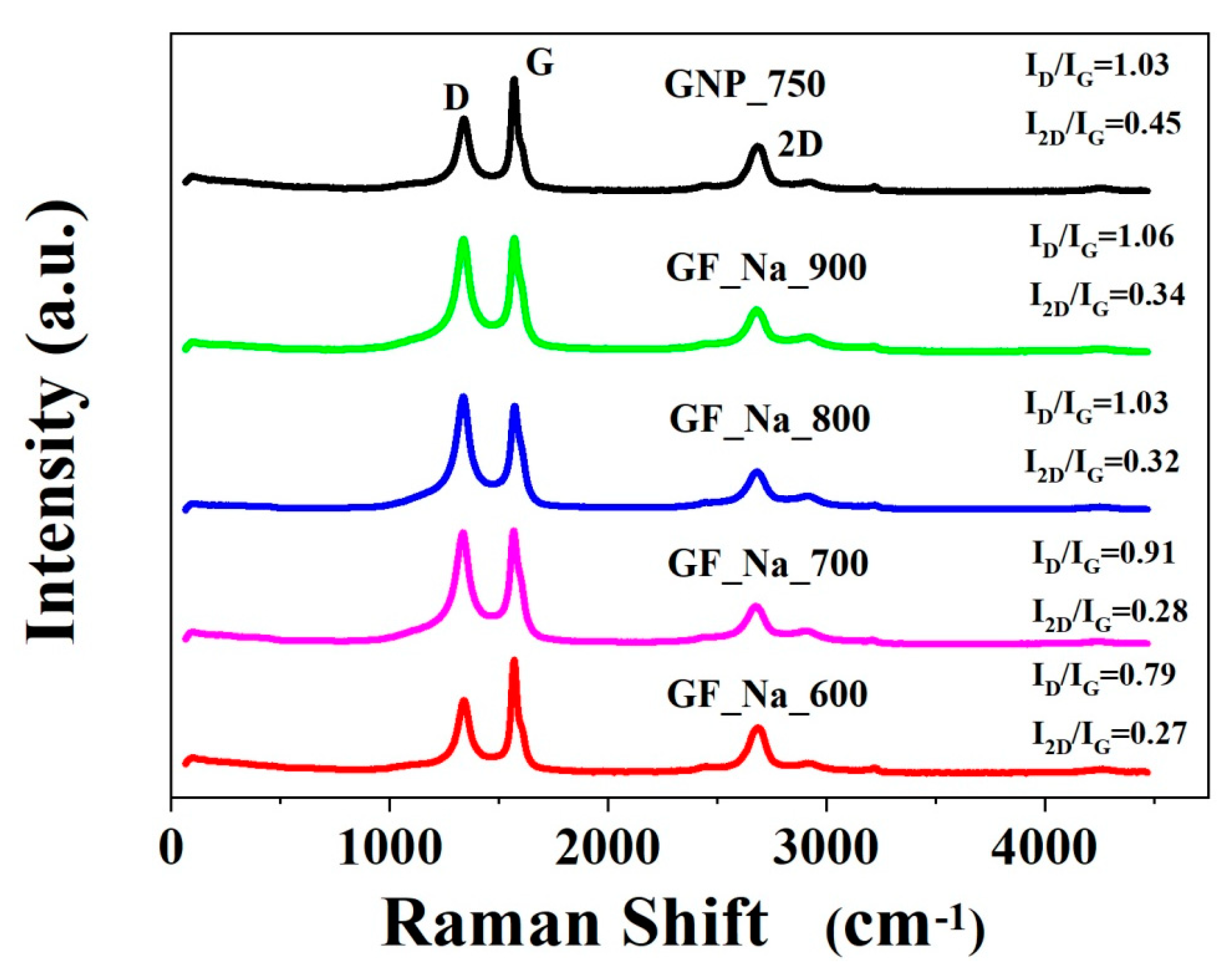3D-Structured and Blood-Contact-Safe Graphene Materials
Abstract
:1. Introduction
2. Results and Discussion
3. Methods and Materials
3.1. The Synthesis of 3D Graphene
3.2. Materials Characterization
3.3. DPPH Radical Scavenging Assay
- AbsDPPH is the absorbance of the fresh DPPH solution;
- AbsPB is the absorbance of the fresh DPPH solution after contact with tested samples.
3.4. Blood Compatibility
- [OD] specimen is the absorbance of solution in contact with tested samples;
- [OD] negative is the absorbance of blood in physiological saline;
- [OD] positive is the absorbance of blood in water.
4. Conclusions
Author Contributions
Funding
Institutional Review Board Statement
Informed Consent Statement
Data Availability Statement
Conflicts of Interest
Abbreviations
| 3D graphene | three-dimensional (micro-mesoporous) graphene |
| SEM | scanning electron microscopy |
| HRTEM | high-resolution transmission electron microscopy |
| XPS | X-ray photoelectron spectroscopy |
| DPPH | 2,2-Diphenyl-1-picrylhydrazyl, free radical, 95% |
| RSA | radical scavenging activity |
| CTAC | cationic surfactant—cetyltrimethylammonium chloride solution |
| NMP | 1-methyl-2-pyrrolioline |
| GNP’s | graphene nanoplatelets |
| FLG | few-layer graphene |
| GNP_300 | graphene nanoplatelets with surface area 300 m2/g |
| GNP_750 | graphene nanoplatelets with surface area 750 m2/g |
| GF_Na_T | means the mass ratio of graphene nanoplatelets (2 g) to Na2CO3 (6 g) carbonized in the temperature range 600–900 °C |
| GF_Na_raw | means the sample after modifications with Na2CO3 but before carbonization. |
References
- Chen, X.; Tian, Y. Review of Graphene in Cathode Materials for Lithium-Ion Batteries. Energy Fuels 2021, 35, 3572–3580. [Google Scholar] [CrossRef]
- Akbar, S.S.; Rehan, M.; Haiyang, L.; Rafique, I.; Akbar, H. A brief review on graphene applications in rechargeable lithium ion battery electrode materials. Carbon Lett. 2018, 28, 1–8. [Google Scholar]
- Lavagna, L.; Meligrana, G.; Gerbaldi, C.; Tagliaferro, A.; Bartoli, M. Graphene and Lithium-Based Battery Electrodes: A Review of Recent Literature. Energies 2020, 13, 4867. [Google Scholar] [CrossRef]
- Mandal, P.; Debbarma, J.; Saha, M. A Review on the Emergence of Graphene in Photovoltaics Industry. Biointerface Res. Appl. Chem. 2021, 11, 15009–15036. [Google Scholar]
- Rosli, N.N.; Ibrahim, M.A.; Ludin, N.A.; Teridi, M.A.M.; Sopian, K. A review of graphene based transparent conducting films for use in solar photovoltaic applications. Renew. Sustain. Energy Rev. 2019, 99, 83–99. [Google Scholar] [CrossRef]
- Ścigała, A.; Szczęsny, R.; Kamedulski, P.; Trzcinski, M.; Szłyk, E. Copper nitride/silver nanostructures synthesized via wet chemical reduction method for the oxygen reduction reaction. J. Nanopart Res. 2023, 25, 28. [Google Scholar] [CrossRef]
- Kamedulski, P.; Truszkowski, S.; Lukaszewicz, J.P. Highly Effective Methods of Obtaining N-Doped Graphene by Gamma Irradiation. Materials 2020, 13, 4975. [Google Scholar] [CrossRef]
- Kamedulski, P.; Lukaszewicz, J.P.; Witczak, L.; Szroeder, P.; Ziolkowski, P. The Importance of Structural Factors for the Electrochemical Performance of Graphene/Carbon Nanotube/Melamine Powders towards the Catalytic Activity of Oxygen Reduction Reaction. Materials 2021, 14, 2448. [Google Scholar] [CrossRef]
- Kamedulski, P.; Skorupska, M.; Binkowski, P.; Arendarska, W.; Ilnicka, A.; Lukaszewicz, J.P. High surface area micro-mesoporous graphene for electrochemical applications. Sci. Rep. 2021, 11, 22054. [Google Scholar] [CrossRef]
- Kamedulski, P.; Gauden, P.A.; Lukaszewicz, J.P.; Ilnicka, A. Effective Synthesis of Carbon Hybrid Materials Containing Oligothiophene Dyes. Materials 2019, 12, 3354. [Google Scholar] [CrossRef]
- Xiang, Y.; Xin, L.; Hu, J.; Li, C.; Qi, J.; Hou, Y.; Wei, X. Advances in the Applications of Graphene-Based Nanocomposites in Clean Energy Materials. Crystals 2021, 11, 47. [Google Scholar] [CrossRef]
- Chandrasekaran, S.; Cerón, M.R.; Worsley, M.A. Chapter 1. Engineering the Architecture of 3D Graphene-based Macrostructures. In Graphene-Based 3D Macrostructures for Clean Energy and Environmental Applications; Balasubramanian, R., Chowdhury, S., Eds.; Royal Society of Chemistry: London, UK, 2021; pp. 1–40. [Google Scholar]
- Sun, Y.W.; Liu, W.; Hernandez, I.; Gonzalez, J.; Rodriguez, F.; Dunstan, D.J.; Humphreys, C.J. 3D Strain in 2D Materials: To What Extent is Monolayer Graphene Graphite? Phys. Rev. Lett. 2019, 123, 135501. [Google Scholar] [CrossRef] [PubMed] [Green Version]
- Kamedulski, P.; Ilnicka, A.; Lukaszewicz, J.P.; Skorupska, M. Highly effective three-dimensional functionalization of graphite to graphene by wet chemical exfoliation methods. Adsorption 2019, 25, 631–638. [Google Scholar] [CrossRef]
- Syama, S.; Mohanan, P.V. Comprehensive Application of Graphene: Emphasis on Biomedical Concerns. Nano Micro Lett. 2019, 11, 6. [Google Scholar] [CrossRef] [PubMed]
- Jampilek, J.; Kralova, K. Advances in Biologically Applicable Graphene-Based 2D Nanomaterials. Int. J. Mol. Sci. 2022, 23, 6253. [Google Scholar] [CrossRef]
- Crowder, S.W.; Prasai, D.; Rath, R.; Balikov, D.A.; Bae, H.; Bolotin, K.I.; Sung, H.-J. Three-dimensional graphene foams promote osteogenic differentiation of human mesenchymal stem cells. Nanoscale 2013, 5, 4171–4176. [Google Scholar] [CrossRef]
- Amani, H.; Mostafavi, E.; Arzaghi, H.; Davaran, S.; Akbarzadeh, A.; Akhavan, O.; Pazoki-Toroudi, H.; Webster, T.J. Three-Dimensional Graphene Foams: Synthesis, Properties, Biocompatibility, Biodegradability, and Applications in Tissue Engineering. ACS Biomater. Sci. Eng. 2019, 5, 193–214. [Google Scholar] [CrossRef]
- Tiwari, S.; Patil, R.; Dubey, S.K.; Bahadur, P. Graphene nanosheets as reinforcement and cell-instructive material in soft tissue scaffolds. Adv. Colloid Interface Sci. 2020, 281, 102167. [Google Scholar] [CrossRef]
- Rostami, F.; Tamjid, E.; Behmanesh, M. Drug-eluting PCL/graphene oxide nanocomposite scaffolds for enhanced osteogenic differentiation of mesenchymal stem cells. Mater. Sci. Eng. C 2020, 115, 111102. [Google Scholar] [CrossRef]
- Luong-Van, E.K.; Madanagopal, T.T.; Rosa, V. Mechanisms of graphene influence on cell differentiation. Mater. Today Comm. 2020, 16, 100250. [Google Scholar] [CrossRef]
- Dolatkhah, M.; Hashemzadeh, N.; Barar, J.; Adibkia, K.; Aghanejad, A.; Barzegar-Jalali, M.; Omidi, Y. Graphene-based multifunctional nanosystems for simultaneous detection and treatment of breast cancer. Colloids Surf. B Biointerfaces 2020, 193, 111104. [Google Scholar] [CrossRef] [PubMed]
- Wang, Y.; Li, J.; Li, X.; Shi, J.; Jiang, Z.; Zhang, C.Y. Graphene-based nanomaterials for cancer therapy and anti-infections. Bioact. Mater. 2022, 14, 335–349. [Google Scholar] [CrossRef] [PubMed]
- Rouxhet, P.G.; Genet, M.J. XPS analysis of bio-organic systems. Surf. Interface Anal. 2011, 43, 1453–1470. [Google Scholar] [CrossRef]
- Yumitori, S. Correlation of C1s chemical state intensities with the O1s intensity in the XPS analysis of anodically oxidized glass-like carbon samples. J. Mater. Sci. 2000, 35, 139–146. [Google Scholar] [CrossRef]
- Beamson, G.; Briggs, D. High Resolution XPS of Organic Polymers: The Scienta ESCA300 Database. J. Chem. Educ. 1993, 70, A25. [Google Scholar]
- Genet, M.J.; Dupont-Gillain, C.C.; Rouxhet, P.G. XPS Analysis of Biosystems and Biomaterials. In Medical Applications of Colloids; Matijevic, E., Ed.; Springer: Berlin, Germany; Science Business Media LLC: New York, NY, USA, 2008. [Google Scholar]
- Hulicova-Jurcakova, D.; Seredych, M.; Lu, G.Q.; Bandosz, T.J. Combined Effect of Nitrogen- and Oxygen-Containing Functional Groups of Microporous Activated Carbon on its Electrochemical Performance in Supercapacitors. Adv. Funct. Mater. 2009, 19, 438–447. [Google Scholar] [CrossRef]
- Hao, Y.; Wang, Y.; Wang, L.; Ni, Z.; Wang, Z.; Wang, R.; Koo, C.K.; Shen, Z.; Thong, J.T.L. Probing Layer Number and Stacking Order of Few-Layer Graphene by Raman Spectroscopy. Small 2010, 6, 195–200. [Google Scholar] [CrossRef]
- Thorarinsdottir, H.; Kander, T.; Johansson, D.; Nilsson, B.; Klarin, B.; Sanchez, J. Blood compatibility of widely used central venous catheters; an experimental study. Sci. Rep. 2022, 12, 8600. [Google Scholar] [CrossRef]
- Kaczmarek, B. Improving sodium alginate films properties by phenolic acid addition. Materials 2020, 13, 2895. [Google Scholar] [CrossRef]
- Qiu, Y.; Wang, Z.; Owens, A.C.E.; Kulaots, I.; Chen, Y.; Kane, A.B.; Hurt, R.H. Antioxidant chemistry of graphene-based materials and its role in oxidation protection technolog. Nanoscale 2014, 6, 11744. [Google Scholar] [CrossRef]
- Meng, X.; Cheng, Y.; Wang, P.; Chen, K.; Chen, Z.; Liu, X.; Fu, X.; Wang, K.; Liu, K.; Liu, Z.; et al. Enhanced Hemocompatibility of a Direct Chemicla Vapor Deposition-Derived Graphene Film. ACS Appl. Mater. Interfaces 2021, 13, 4835–4843. [Google Scholar] [CrossRef] [PubMed]
- Pires, A.L.R.; Motta, L.A.; Dias, A.M.A.; de Sousa, H.C.; Moraes, Â.M.; Braga, M.E.M. Towards wound dressings with improved properties: Effects of poly(dimethylsiloxane) on chitosan-alginate films loaded with thymol and beta-carotene. Mater. Sci. Eng. C 2018, 93, 595–605. [Google Scholar] [CrossRef] [PubMed]
- Kedare, S.B.; Singh, R.P. Genesis and development of DPPH method of antioxidant assay. J. Food Sci. Technol. 2011, 48, 412–422. [Google Scholar] [CrossRef] [PubMed] [Green Version]
- Vishnu, J.; Calin, M.; Pilz, S.; Gebert, A.; Kaczmarek, B.; Michalska-Sionkowska, M.; Hoffmann, V.; Manivasagam, G. Superhydrophilic nanostructured surfaces of beta Ti29Nb alloy for cardiovascular stent applications. Surf. Coat. Technol. 2020, 396, 125965. [Google Scholar] [CrossRef]




| Sample | Elemental Analysis (wt.%) | SBET (m2/g) | Vt (cm3/g) | Vmi (cm3/g) | Vme (cm3/g) | Vme/Vt × 100% | ||
|---|---|---|---|---|---|---|---|---|
| C | N | H | ||||||
| GNP_750 | 87.3 | 0.7 | 0.9 | 750 | 0.999 | 0.127 | 0.872 | 87% |
| GF_Na_600 | 90.9 | 0.4 | 0.8 | 330 | 0.220 | 0.141 | 0.079 | 36% |
| GF_Na_700 | 91.6 | 0.5 | 1.0 | 332 | 0.248 | 0.133 | 0.115 | 46% |
| GF_Na_800 | 92.9 | 0.4 | 0.7 | 357 | 0.279 | 0.127 | 0.152 | 54% |
| GF_Na_900 | 93.7 | 0.6 | 0.9 | 391 | 0.377 | 0.078 | 0.299 | 79% |
| Element | C | O | N | ||||||
|---|---|---|---|---|---|---|---|---|---|
| Binding energy (eV) | 285.0 | 286.3 | 287.7 | 288.6 | % of total | 532.0 | 533.3 | % of total | 400.5 |
| Sample | Content (at.%) | Content (at.%) | Content (at.%) | ||||||
| GF_Na_800 | 44.2 | 30.3 | 9.8 | 4.2 | 88.6 | 4.9 | 4.7 | 9.6 | 1.8 |
| Sample | ID | cm−1 | IG | cm−1 | I2D | cm−1 | ID/IG | I2D/IG |
|---|---|---|---|---|---|---|---|---|
| GNP_750 | 1.00 | 1344.5 | 0.98 | 1579.0 | 0.44 | 2679.0 | 1.03 | 0.45 |
| GF_Na_600 | 0.99 | 1337.0 | 1.00 | 1592.0 | 0.38 | 2703.5 | 0.79 | 0.27 |
| GF_Na_700 | 0.99 | 1345.5 | 1.00 | 1587.0 | 0.37 | 2695.0 | 0.91 | 0.28 |
| GF_Na_800 | 1.00 | 1343.0 | 1.00 | 1584.0 | 0.37 | 2699.0 | 1.03 | 0.32 |
| GF_Na_900 | 1.00 | 1343.0 | 1.00 | 1582.0 | 0.36 | 2687.0 | 1.06 | 0.34 |
| Specimen | RSA% |
|---|---|
| GNP_300 | 77.61 ± 0.12 |
| GNP_750 | 84.72 ± 1.11 |
| GF_Na_raw | 57.92 ± 0.44 |
| GF_Na_600 | 80.51 ± 2.96 |
| GF_Na_700 | 83.93 ± 0.75 |
| GF_Na_800 | 89.00 ± 0.21 |
| GF_Na_900 | 71.85 ± 0.63 |
| Specimen | Rate of Hemolysis [%] |
|---|---|
| GNP_300 | 0.29 ± 0.21 |
| GNP_750 | 0.49 ± 0.25 |
| GF_Na_raw | 0.28 ± 0.08 |
| GF_Na_600 | 0.50 ± 0.11 |
| GF_Na_700 | 0.53 ± 0.10 |
| GF_Na_800 | 0.58 ± 0.33 |
| GF_Na_900 | 0.64 ± 0.08 |
Disclaimer/Publisher’s Note: The statements, opinions and data contained in all publications are solely those of the individual author(s) and contributor(s) and not of MDPI and/or the editor(s). MDPI and/or the editor(s) disclaim responsibility for any injury to people or property resulting from any ideas, methods, instructions or products referred to in the content. |
© 2023 by the authors. Licensee MDPI, Basel, Switzerland. This article is an open access article distributed under the terms and conditions of the Creative Commons Attribution (CC BY) license (https://creativecommons.org/licenses/by/4.0/).
Share and Cite
Kaczmarek-Szczepańska, B.; Michalska-Sionkowska, M.; Binkowski, P.; Lukaszewicz, J.P.; Kamedulski, P. 3D-Structured and Blood-Contact-Safe Graphene Materials. Int. J. Mol. Sci. 2023, 24, 3576. https://doi.org/10.3390/ijms24043576
Kaczmarek-Szczepańska B, Michalska-Sionkowska M, Binkowski P, Lukaszewicz JP, Kamedulski P. 3D-Structured and Blood-Contact-Safe Graphene Materials. International Journal of Molecular Sciences. 2023; 24(4):3576. https://doi.org/10.3390/ijms24043576
Chicago/Turabian StyleKaczmarek-Szczepańska, Beata, Marta Michalska-Sionkowska, Pawel Binkowski, Jerzy P. Lukaszewicz, and Piotr Kamedulski. 2023. "3D-Structured and Blood-Contact-Safe Graphene Materials" International Journal of Molecular Sciences 24, no. 4: 3576. https://doi.org/10.3390/ijms24043576
APA StyleKaczmarek-Szczepańska, B., Michalska-Sionkowska, M., Binkowski, P., Lukaszewicz, J. P., & Kamedulski, P. (2023). 3D-Structured and Blood-Contact-Safe Graphene Materials. International Journal of Molecular Sciences, 24(4), 3576. https://doi.org/10.3390/ijms24043576











